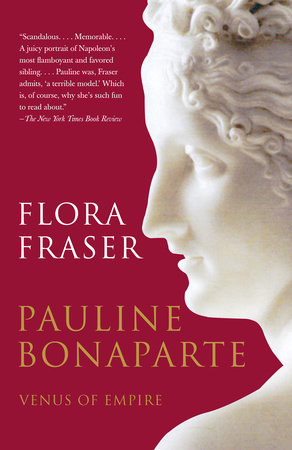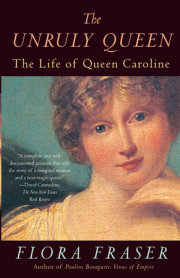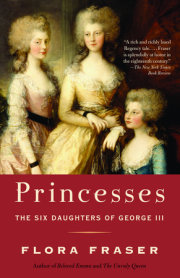CHAPTER ONE
Dinner at Marseille, 1796
The story of Pauline Bonaparte, legendary beauty and seductress, begins, appropriately, with a meeting of three men. At dinner in the port of Marseille in the south of France were her elder brother General Napoleon Bonaparte, her fiancé, Citizen Stanislas Fréron, and her future husband, Adjutant General Victor Emmanuel Leclerc. According to the Gregorian calendar it was March 22, 1796. But that annual register had been suppressed, and, according to the Revolutionary calendar, which the national government had instituted with effect from September 1792, the day was 2 Germinal, Year Four.
We have no record of what Pauline Bonaparte herself was doing on that day in Marseille. Fifteen years old, with her widowed mother, Letizia, and others of her siblings she had been an inhabitant of the south of France since dramatic events had caused them to flee their native Corsica. The island was in the throes of a struggle for independence backed in its early stages by members of the Bonaparte family. Latterly Napoleon and his brothers had supported the French Revolution, an adherence that had brought them into conflict with Corsican patriots. The family had settled first at Toulon and then in Marseille in 1793.
Nor indeed until shortly before this dinner do we have much reliable information about Pauline’s individual life. Her birth on October 20, 1780—she was the sixth of eight children—was recorded by her father, Charles, in his
livre de raison, or commonplace book, which survives him. (He died when she was four.) The date of her baptism the next day in the small cathedral of Ajaccio in Corsica—Archdeacon Luciano Bonaparte, her great-uncle, stood godfather—is recorded in that town’s archives. She was christened Maria Paola, and as she grew up was known as Paoletta. With the later fame of her brother Napoleon eclipsing all interest in the stories of his siblings, Pauline’s childhood in the Maison Bonaparte in the harbor town of Ajaccio is distinguished by only a few mentions in the correspondence and anecdotes his admirers have so avidly collected.
When she was eleven, in 1792, Napoleon, aged twenty-two, sent her a fashion plate. Writing in the same month about her elder sister, Elisa, who had been educated far from Corsica at Madame de Maintenon’s convent school of Saint-Cyr, and doubting the overeducated girl’s chances in marriage, Napoleon mused that she was much less knowing than Paoletta. Both references, at once telling of Napoleon’s affection for Pauline, of her love of finery, and of her mischievous character, might seem invented did they not come from reputable sources. Years later, while in exile on Elba, the emperor remembered that he and his sister had been caught mimicking their crippled grandmother, who was “bent . . . like an old fairy,” and that Letizia punished Pauline rather than him—“it being easier to pull up skirts than undo breeches.” If true, the story testifies to the harsh justice that the Bonapartes’ mother meted out as well as to the taste this brother and sister displayed all their lives for unkind fun.
In the absence of other details about Pauline, these slivers of family life must represent her childhood years, her squabbles and games with elder brother Louis and younger siblings Maria Annunziata (always known as Caroline) and Jérôme. More generally her mother later spoke of a room in the Maison Bonaparte given over to the children, where they were allowed to play as they pleased, even scribble on the walls. That not much education—at most a dame school or the teaching of nuns—entered the lives of these younger Bonaparte children we know from later references to Pauline’s deficiencies in this area. A good deal of healthy living was part of the picture, and through the difficult years when, following the early death of Pauline’s father, Charles, the family might have been classed as
pauvre, or unable to sustain themselves, they still summered at I Milleli, a substantial house in the maquis, or mountain scrub, above Ajaccio. It was here that Paoletta, her mother, and other siblings sheltered in the summer of 1793 when fleeing Corsican patriots, who had set fire to their home in Ajaccio following provocative remarks by her elder brother Lucien Bonaparte in a Jacobin club. From the nearby seashore they were sensationally rescued by Napoleon, and a French frigate bore them to the relative safety of the south of France. There Paoletta soon became known as Paulette, a gallicization that gradually gave way to Pauline.
But enough of vague accounts of a childhood we cannot reconstitute. Let us return to the dinner table in Marseille on March 22, 1796, and to the three men at it—Bonaparte, Fréron, and Leclerc. All three had been dedicated to the Revolution since it had first broken out in Paris on July 14, 1789, and all of them had played a distinguished part during its subsequent transformations. The Bourbon king Louis XVI had been executed in January 1793, and France, already steeped in blood at home, was now at war. Its enemies—Great Britain, Austria, Prussia, Spain, and Naples—had banded together to stop the French national government from spreading revolution throughout Europe and to support French royalists in their bid to restore the Bourbon monarchy. Although this struggle, which has since become known as the War of the First Coalition, provided the inescapable backdrop as the men dined that spring evening, we know that two of them at least had Paulette Bonaparte much in mind.
Despite the difference in their ages—he was forty-one to her fifteen—Stanislas Fréron had every intention of marrying Pauline within days, and her elder brother Napoleon favored the match, as well he might: Fréron was a person of consequence. He had been the national government’s choice to take up the appointment of proconsul in Marseille the previous year and reestablish order in a city torn by faction and still bruised from the excesses of Robespierre’s Revolutionary Terror of two years earlier. He had succeeded wonderfully well in his task, aided by one of the two younger men at the dinner, Adjutant General Leclerc, who had restored discipline to the disorderly troops in the town garrison. The third man at the table, General Bonaparte, had interrupted important preparations at Toulon for the launch of an Italian campaign to come and inspect the Marseille garrison, and this dinner marked the end of his visit and the successful conclusion of Fréron’s and Leclerc’s mission.
Some criticized the pomp and extravagance in which Fréron had lived at Marseille since his arrival the previous November, likening his behavior to that of a “Persian viceroy.” The house he had commandeered was illuminated day and night by lanterns, and he never ventured out without a large suite of attendants. But he ordered theater and bullfights, which pleased the Marseillais. The salons of the city, slowly opening again following the overthrow of Robespierre and the installation of the new government called the Directory, marveled at his wit and address. He had been brought up, before the Revolution, in the household of Louis XVI’s aunts, and among his attractions for the young Pauline Bonaparte was the lordly air he had preserved. When, exactly, over the past few months Pauline had come to the attention of this magnificent, decadent Parisian being, and where they had first met, we do not know. But it was almost certainly Lucien, acting as Fréron’s aide-de-camp in Marseille, who introduced them. From political life in Paris Fréron knew the three eldest Bonaparte brothers, Napoleon, Joseph, and Lucien—and indeed had singled out for praise in the Convention, the national assembly that preceded the Directory, Napoleon’s conduct in a royalist insurrection. Napoleon, meanwhile, noted with approval his brother Lucien’s appointment to Fréron’s staff.
What is certain is that Pauline and the other Bonaparte females would have known of Fréron long before they encountered him during this pacificatory mission to Marseille. For, after they left their native Corsica in the summer of 1793, they lived between Toulon and Marseille in the south of France. And in the summer of 1794 in the Midi, Fréron’s name was synonymous with the Terror, after he had, with Paul Barras, been dispatched by Robespierre and the Committee of Public Safety to oversee in that region the national bloodshed in the Revolution’s name that so horrified the rest of Europe. In Marseille he and his fellow commissioner, Barras, punished those who had backed the Girondins, moderate opponents of Robespierre’s Jacobins. In Toulon they exacted vengeance on the royalist town for turning to the English. (It was at the siege of Toulon in late 1793 that the twenty-four-year-old Napoleon had first made his name, dispersing the British fleet in his capacity as captain of artillery.)
During this return visit two years later to the scene of his earlier crimes, however, Fréron had now succeeded by wise government in conciliating many. The day after the dinner, on March 23, 1796, General Napoleon Bonaparte reported from Toulon to Barras, now a member of the Directory, “Fréron has behaved well at Marseille. They seem to fear his departure and the renewal of assassinations.” And on the thirtieth of that month from Nice he repeated his encomium to the same correspondent: “I found Fréron at Marseille. His departure has been a matter for regret—it seems he has behaved well there.”
Fréron had certainly succeeded in attracting the heartfelt passion of Pauline Bonaparte, and already six weeks before Napoleon’s visit to Marseille their imminent marriage was the subject of discussion between them. The fifteen-year-old girl was preparing herself to leave her family and follow Fréron, wherever the government might next send him. “. . . I swear, dear Stanislas, ever to love but you alone,” Pauline wrote on 19 Ventôse (February 9). “My heart is not for sharing. It’s given to you whole. Who could oppose the union of two souls who seek only happiness and who find it in loving each other? No, my love, not Maman, not anyone can refuse you my hand.” She went on, “Laura and Petrarch, whom you quote often, were not so happy as us. Petrarch was constant, but Laura . . . No, my dear love, Paulette will love you as much as Petrarch loved Laura.”
This rather surprising excursus into the world of Renaissance literature requires some explanation. We know that Fréron admired and translated into French the Italian poet’s sonnets. That he shared his knowledge of Petrarch, and of the sonnets dedicated to “Laura”—the woman the poet claims to have first seen in a church in Avignon and who, being married, could never return his passion—with Pauline, an ignorant and more or less unlettered refugee from Corsica, says much for the power of love to transcend all boundaries. It is probable that Pauline had help from someone more literate than herself in framing this and subsequent letters, to her “idol” Fréron. Her brother Lucien and her sister Elisa have been suggested as possible secretaries. But Fréron’s teaching left an indelible impression on Pauline. Later in life she was to take pleasure in reciting the lines from Petrarch he had taught her—to other lovers.
Pauline’s reference to her mother shows that Fréron had not succeeded in conciliating all at Marseille: “No, my love, not Maman, not anyone can refuse you my hand.” Following the early death of her husband, Charles, in 1785, Letizia Bonaparte had shared the duties that would have naturally fallen to him, as father of a family of five boys and three girls, with her two eldest sons, Joseph and Napoleon. Hence resistance from her to the match that Pauline and Fréron contemplated was to be taken seriously, even if Napoleon was in favor. (Within the family Napoleon was a figure of greater authority than his elder brother. In part this was because, unlike Joseph, he had spent months at a time at home in Corsica, helping his mother in her quest to make ends meet. In part he had the more dominant character.) That Madame Bonaparte objected, or at least wished the couple to delay their marriage, is made clear in a letter from Fréron to Napoleon days after his dinner with the young general. His mission concluded, Fréron was on the point of journeying north to Paris, where he had been called by the Directory, and intended taking Pauline with him as Madame Fréron:
Your mother is putting an obstacle in our way. I hold to the idea of marrying in Marseille in four or five days’ time. Everything is arranged for that. Independently of possessing this hand that I burn to unite to mine, it is possible that the Directory will name me straightaway to some distant post, which will mean an immediate departure. If I am obliged to come back here, I will lose precious time. Moreover, the government, which, rightly, occupies itself little with matters of the heart, might blame an absence that could retard [the object of] the mission entrusted to me.
On what ground Madame Bonaparte objected to her daughter’s marriage to Fréron we do not know. The bridegroom’s age may have been a factor—or, indeed, the bride’s youth. Or, being endowed with a remarkable ability to see which way the wind was blowing, Madame Bonaparte may have had some inkling, either from her links with the Corsican community in Paris or from information from the merchant community of Marseille with whom the Bonapartes were friendly, and indeed into which her son Joseph had recently married, that Fréron’s earlier crimes in the south were about to come back to haunt him. She may even have known of and objected to the five-year liaison that Fréron had enjoyed with an actress from the Italian theater. Two children had been born, and the actress was pregnant with a third. But her objections were certainly not shared at this point by her son Napoleon. Indeed Pauline later reminded him, “You consented to my marriage to Fréron,” and referred to “the promises you made me to smooth all obstacles.”
It was perhaps surprising that Madame Bonaparte made objections to her daughter’s marriage. When she and her children had fled Ajaccio for the mainland after the Maison Bonaparte had been burned down, the modest income they derived from the produce of vineyards and other smallholdings on their native island had come to an end. Indeed Corsica was now in British hands. In addition the support of a close-knit if quarrelsome structure of relations—paternal and maternal—had been lost to them. In Toulon, where they landed in June 1793, and afterward in Marseille, they had had to depend on small sums that the new republican government meted out to refugees from Corsica. Legend even has it that the Bonaparte women resorted to taking in laundry and washed it in the public fountain.
Now, however, in the spring of 1796, Napoleon had been appointed to head the Army of Italy, which had as its mission the expulsion of the Austrians from northern Italy and the introduction of republican government into that region. As a result he was able to supplement his family’s income from his salary. Equally Madame Bonaparte’s stepbrother, François Fesch, who had escaped with them from Corsica, had recovered some of his Swiss father’s patrimony and could also help. Fesch, whose vocation was the priesthood and who had earlier been archdeacon of Ajaccio after Luciano Bonaparte’s death, had been living a secular life since religious orders were suppressed under the Revolution.
Copyright © 2009 by Flora Fraser. All rights reserved. No part of this excerpt may be reproduced or reprinted without permission in writing from the publisher.











